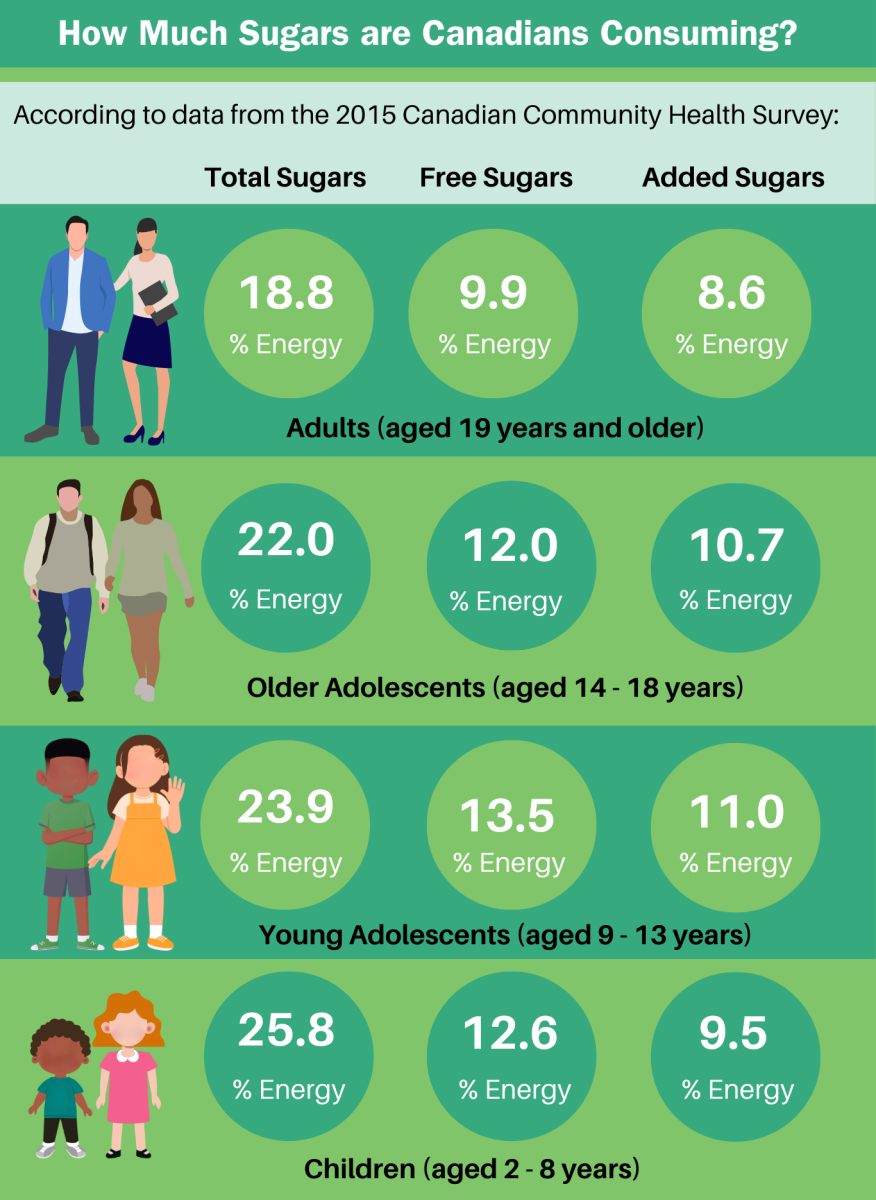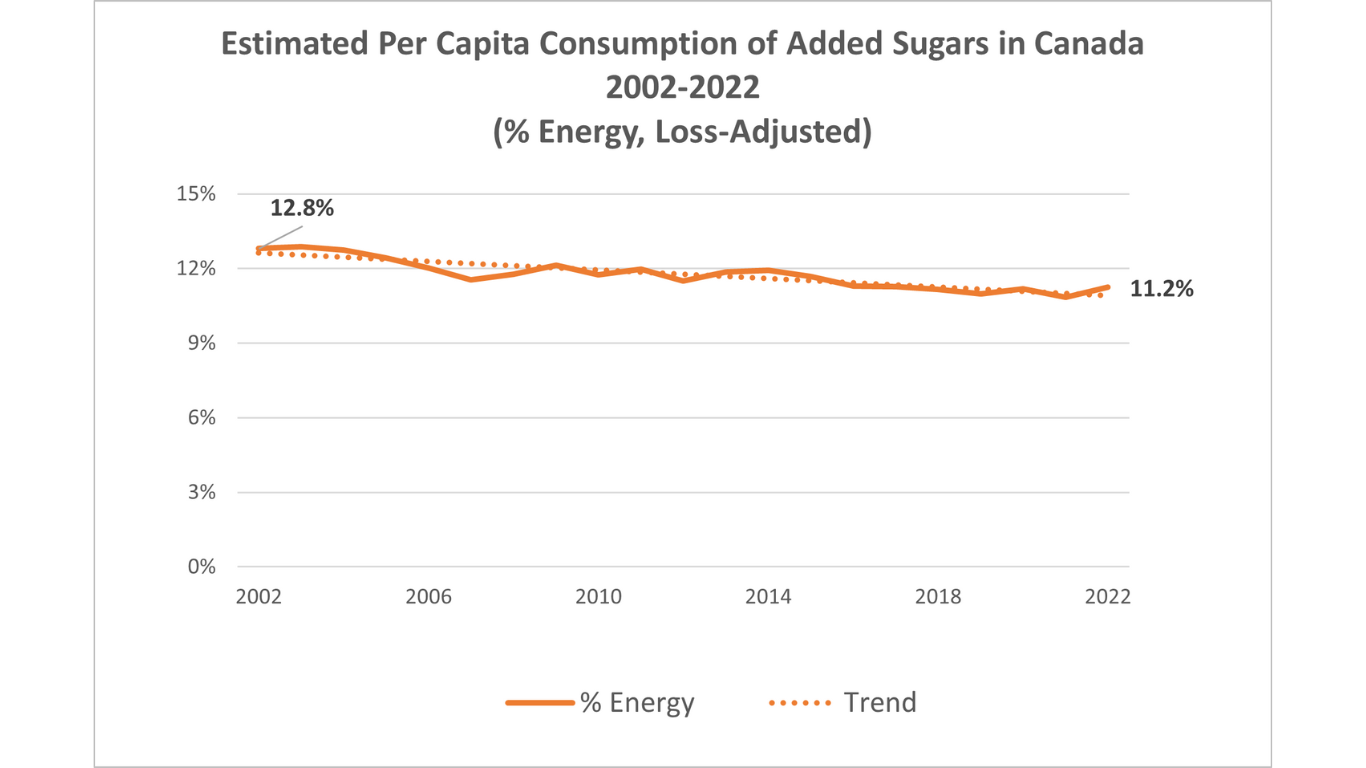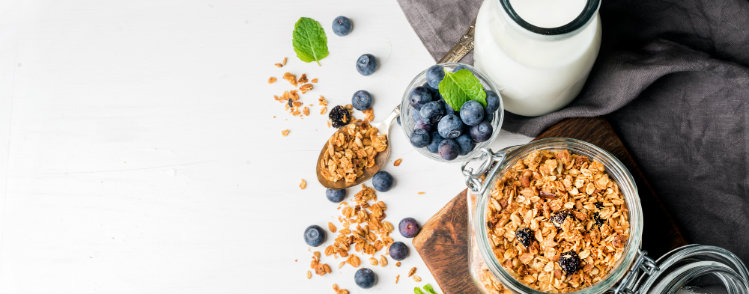Sugar has been a part of the human diet for centuries but recently there has been a lot of media attention focused on sugar, particularly in relation to weight and health. Much of this information is not supported by science and is often misleading and incomplete. It can therefore be challenging for consumers to separate fact from fiction. This page answers five of the most frequently asked questions about sugars in relation to health. For answers to questions on additional topics below, below visit the respective sections:

Question: Are Canadians eating too much added sugars?
Answer: On average, Canadians consume about 11% of energy from added sugars - an amount that has been declining over the past 20 years.
Added Sugars Intake in Canada:
- Canadian dietary survey data (CCHS) provides the best available information on sugars intakes in Canada.
- On average, Canadians get about 11% of their daily energy from added sugars. This is close to international dietary guidelines that recommend limiting added sugars to less than 10% energy1.
- “Added sugars” includes all sugars and syrups added to foods and drinks at home and by food manufacturers but does not include naturally occurring sugars, such as in fruit, fruit juice, and unsweetened dairy products.
- Intakes of added sugars vary by age group:
- Adults consume the lowest amounts of added sugars, with an average of 8.6% energy2.
- Adolescents consume higher amounts,with an average above a 10% guideline3.
- Fruit is the top source of total sugars for all age groups. Adults and adolescents consume a higher proportion of their sugars from added sources, like soft drinks, baked goods, and frozen desserts2,3.
- Those consuming a moderate amount of total and added sugars have higher intakes of some key nutrients and vitamins and minerals, such as vitamin C and potassium, due to higher intakes of fruit and dairy products2,3.

Trends in Added Sugars Intakes:
- According to market availability trends, added sugars intake in Canada has gradually decreased over the past 20 years4.
- Similar declines in added sugars consumption have been seen in other countries like the United States, United Kingdom, and Australia4.
- Media articles in Canada often quote American sugars consumption statistics, however our eating patterns are different. Canadian adults consume nearly 1/3 less added sugars than US adults, mostly because they drink fewer soft drinks4.

Data source: Statistics Canada, Table 32-10-0054-01, Food available in Canada. Adjusted for waste using updated USDA Loss-Adjusted Food Availability Documentation. Added sugars include refined sugar, maple sugar, honey, and sugars in soft drinks.
Note: Variability in sugars and syrups reflects substitution with high fructose corn syrup in soft drinks, and the total amount of sugars, syrups and soft drinks is an overestimate in some years. Soft drink data also includes non-caloric soft drinks (which do not contain sugars); therefore, sugars in soft drinks is an overestimate.
For more information, visit: Consumption of Sugars in Canada, or download the fact sheet: Frequently Asked Questions: Sugars Consumption
References:
1) Dietary Guidelines for Americans 2020-2025. https://www.dietaryguidelines.gov/
2) Wang Y(F), et al. Canadian Adults with Moderate Intakes of Total and Added Sugars Have Greater Intakes of Fibre and Key Micronutrients. Nutrients. 2020;12:(4):1124.
3) Chiavroli L, et al. Intakes of Nutrients and Food Categories in Children and Adolescents Across Levels of Sugars Intake. Appl Physiol Nutr Met. 2022;47(4):415-28.
4) Wang Y(F), et al. Trends in Loss-Adjusted Availability of Added Sugars and Energy Contribution from Macronutrients and Major Food Groups in Canada and the United States. JANA. 2023;42(5):459-68.
Question: Does sugar cause weight gain and obesity?
Answer: Consuming more calories than your body needs, from all foods and beverages, can contribute to weight gain.
- There are many risk factors for developing obesity, including dietary patterns, level of physical activity, environment, sleep patterns, stress, and genetics1.
- Eating too many calories from all sources - sugars, starches, fats, proteins, alcohol - can contribute to weight gain as calories in excess of energy needs are stored as fat2.
- When sugars are consumed beyond energy needs, research suggests that the dietary sources of sugars are important in addition to providing extra calories3. For example, getting excess calories from sugars-sweetened beverages is more often associated with obesity.
- Based on market availability data, there has been a declining trend in added sugars intake in Canada over the past 10 years. At the same time, rates of obesity continue to rise.
Factors Associated with Body Weight and Obesity
- Diet is just one factor that may increase obesity risk. Getting enough sleep and incorporating physical activity into your day can also help maintain a healthy weight.
- Other factors that play a role in managing weight include your relationship with food, food affordability, culture, and eating behaviours.
- Energy balance is key. You may experience weight gain when you consume more energy from food than you use to perform normal body functions, daily movement, and physical activity.
- Dietary suggestions for maintaining a healthy weight include:
- Choosing a variety of nutrient dense foods more often.
- Moderating portion sizes of foods and snacks to manage the number of calories you consume.
- Choosing water more often and enjoying sugars-sweetened beverages occasionally4.
For more information, visit: Sugars and Overweight and Obesity, or download the fact sheet: Uncover the Truth About Sugar - Obesity
References:
1) World Health Organization. Overweight and Obesity. https://www.who.int/news-room/fact-sheets/detail/obesity-and-overweight
2) Te Morenga L, et al. Dietary sugars and body weight: systematic review and meta-analyses of randomised controlled trials and cohort studies. BMJ. 2012 Jan;346:e7492.
3) Chiavaroli L, et al. Important food sources of fructose-containing sugars and adiposity: A systematic review and meta-analysis of controlled feeding trials. Am J Clin Nutr. 2023; 117(4):741-65.
4). Heart and Stroke. Achieving and Maintaining a Healthy Weight. https://www.heartandstroke.ca/healthy-living/healthy-weight/maintaining-a-healthy-weight
Question: Is there a difference between naturally occurring and added sugars?
Answer: Naturally occurring and added sugars have the same composition and are both used as a source of energy by the body.
- The term “sugar” refers specifically to sucrose, while “sugars” includes all mono- and disaccharides, like glucose, fructose, and lactose.
- Sugars are a type of simple carbohydrate that our cells and body use as a source of energy.
- You can find sugar (sucrose) naturally in fruits and vegetables along with other simple sugars, such as glucose and fructose. Sugar beets and sugar cane are more concentrated sources of sucrose, which is extracted into crystalline table sugar and added to foods at home and by food manufacturers.
- Naturally occurring and added sugars have the same composition and are both used as a source of energy.
- Excess calories, whether from sugars or other foods and beverages, are stored as body fat when consumed in excess of the body’s energy needs.
- Other sugars-based ingredients, including molasses, honey, maple syrup, and high fructose corn syrup, provide similar nutritional values and energy content to sugar.
Key Information about Sugars:
- We typically eat sugar as part of a food or beverage rather than on its own. Other components of the food like fibre, starch, protein, and vitamins and minerals, can impact the food’s nutritional value.
- When we eat fruits and vegetables, we get important nutrients like vitamins, minerals, and fibre. Health Canada suggests getting most of your sugars from naturally occurring sources, like fruits, vegetables, and unsweetened dairy products1.
- Confectionery and desserts can have higher amounts of added sugars, saturated fat, and calories. Canada’s Food Guide recommends choosing these types of foods less often2.
- Small amounts of added sugars can improve the flavour of nutritious foods, like whole grains, breakfast cereals, and flavoured yogurts. Sugar also provides many other functional roles in foods such as helping bread rise, browning in baked goods, balancing acidity in sauces, and acting as a preservative in jams and jellies.
- Most scientific evidence linking added sugars with negative health impacts are based on sugars-sweetened beverages providing excess energy intake3.
For more information, visit: Sources of Sugar, or download the fact sheet: Uncover the Truth About Sugar - Sources of Sucrose
References:
1) Health Canada. Sugars: Sugars and Your Health. https://www.canada.ca/en/health-canada/services/nutrients/sugars.html
2) Canada’s Food Guide. Limit Highly Processed Foods. https://food-guide.canada.ca/en/healthy-eating-recommendations/limit-highly-processed-foods/
3) Chiavaroli L, et al. Important food sources of fructose-containing sugars and adiposity: A systematic review and meta-analysis of controlled feeding trials. Am J Clin Nutr. 2023;117(4):741-65.
Question: Does sugar cause chronic diseases, such as diabetes and heart disease
Answer: Consuming more calories than your body needs from all foods and beverages increases risk of obesity, a risk factor for other chronic diseases.
- Consuming more calories than your body needs, including from sugars and other food sources, can increase your risk of obesity. Having excess body fat (obesity) is a risk factor for chronic diseases such as diabetes and heart disease1.
- Research suggests that high intakes of sugars-sweetened beverages in excess of energy needs may increase the risk of developing certain chronic diseases2-5.
- Other food sources of sugars (e.g. fruit, fruit juice, yogurt, cereals, dairy desserts) have not shown an effect on chronic disease risk factors when consumed within a healthy balanced diet2-5.
- The effect of sugars and other dietary components on chronic disease risk factors depends on energy intake, overall dietary patterns, and non-dietary factors such as physical activity, genetics, age, stress, and lifestyle behaviours.
- Following an overall healthy eating pattern is recommended, rather than focusing only on sugars, or other individual nutrients like sodium or saturated fat6.
Reducing Risk for Chronic Disease:
- There are many different risk factors for developing chronic diseases. Some cannot be controlled (e.g., age, family history, ethnicity), while others can be modified to delay or prevent chronic disease development (e.g., stress, sleep, physical activity, body weight, eating patterns).
- Maintaining a healthy body weight is encouraged as many factors leading to weight gain, such as lack of exercise, an unhealthy dietary pattern, and calorie intake above energy needs, can also contribute to chronic disease risk.
- Diet and lifestyle recommendations to reduce risk of developing diabetes and heart disease include:
- Eating within your energy needs.
- Eating fewer foods and beverages high in added sugars, saturated fat, and sodium.
- Eating more nutrient-dense foods, like fruits, vegetables, and whole grains.
- Limiting alcohol.
- Engaging in regular physical activity7.
For more information, visit: Sugars and Cardiovascular Disease and Sugars and Type 2 Diabetes, or download the fact sheet: Uncover the Truth About Sugar - Chronic Disease
References:
1) Chiavaroli L, et al. Important food sources of fructose-containing sugars and adiposity: A systematic review and meta-analysis of controlled feeding trials. Am J Clin Nutr. 2023;117(4): 741-65.
2) Liu Q, et al. Fructose-containing food sources and blood pressure: A systematic review and meta-analysis of controlled feeding trials. PLoS One. 2023;18(8):e0264802.
3) Choo VL, et al. Food sources of fructose-containing sugars and glycaemic control: systematic review and meta-analysis of controlled intervention studies. BMJ. 2018;363:k4644.
4) Lee D, et al. Important food sources of fructose-containing sugars and non-alcholic fatty liver disease: A systematic review and meta-analysis of controlled trials. Nutrients. 2022;14(14): 2846.
5) Qi X, et al. Effect of important food sources of fructose-containing sugars on inflammatory biomarkers: A systematic review and meta-analysis of controlled feeding trials Nutrients. 2022;14(19):3986.
6) World Health Organization. Healthy diet. https://www.who.int/news-room/fact-sheets/detail/healthy-diet.
7) Heart and Stroke. Healthy Eating. https://www.heartandstroke.ca/healthy-living/healthy-eating
Question: Why id sugar added to foods?
Answer: Sugar is added to foods for its many functional roles, beyond adding sweetness
- Balances flavour. A little bit of sugar balances the acidity of tomato- and vinegar-based products, such as dressings and sauces.
- Improves taste of high-fibre foods. A small amount of sugar can improve the flavour and palatability of high-fibre sources, like bran cereals and plain oatmeal.
- Adds colour and flavour to baked goods. When heated, sugar caramelizes, browning the surface of cakes, breads, and cookies.
- Creates texture and mouthfeel. Sugar helps provide the soft structure in baked foods and the smoothness in frozen dairy products.
- Naturally preserves jams. Sugar absorbs extra moisture to prevent bacteria from growing in jams and preserves.
- Helps bread rise. Sugar is needed for yeast to ferment, which is an essential step in making bread and baked goods.
Sugars Information on Food Labels:
Information on sugars content can be found in several places on food and beverage labels
- Ingredient Listing: All added sugars on food labels are grouped together in the List of Ingredients under the term ‘sugars’1. Examples of sugars ingredients include:
| Sugars-based ingredients listed in the List of Ingredients: | Produced From: |
|---|---|
| Sucrose, sugar, liquid sugar, invert sugar, brown sugar, icing sugar, golden syrup, turbinado sugar, molasses | Sugar cane or sugar beets |
| Glucose-fructose (high-fructose corn syrup), dextrose, glucose, corn syrup solids, high maltose corn syrup | Corn starch |
| Agave syrup, coconut sugar, fruit juice concentrate, honey, maple syrup, rice syrup, sorghum syrup | Other |
- Nutrition Facts Table: “Sugars” in the Nutrition Facts table refers to total sugars1. Total sugars includes all naturally occurring sugars (such as in milk products, fruits, and vegetables), as well as sugars added to foods and beverages.
- The Daily Value for “Sugars” listed in the Nutrition Facts table is 100 grams total sugars (20% energy for a 2,000-calorie diet) and reflects the amount of total sugars consistent with a healthy eating pattern1.
While alternative sweeteners can add sweetness, they cannot fully replace sugar’s unique roles in browning, structure, texture, fermentation, and preservation. This makes it challenging to reduce or remove that amount of sugar in certain recipes, as no single substitute can fulfill all its functions.
If trying to reduce the amount of sugar in a recipe, it is best to experiment by reducing the amount used in small increments and see if the taste, texture, and colour remain to your preference.
For more information, visit: Roles Sugar Plays in Foods, or download the fact sheet: Uncover the Truth About Sugar - Functional Roles.
Reference:
1) Health Canada. Sugars: Using the Food Labels. https://www.canada.ca/en/health-canada/services/nutrients/sugars/using-food-labels.html






